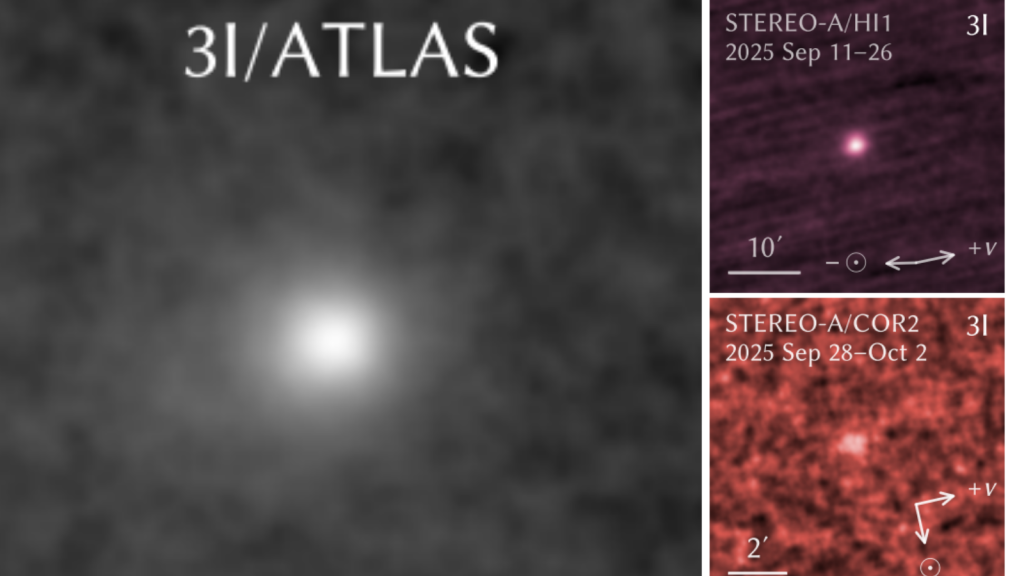Stunning NASA Mission Images Capture Comet Zipping Past Mars
A spectacular celestial event recently unfolded as NASA’s spacecraft around Mars captured NASA mission images of a rare interstellar visitor, comet 3I/ATLAS, as it streaked past the Red Planet. This close encounter offers scientists a precious window into an object from beyond our solar system, helping researchers study its composition, trajectory, and origins in unprecedented detail.
A Rare Interstellar Flyby
Comet 3I/ATLAS is no ordinary space rock. It is only the third confirmed interstellar object, that is, an object that originated outside our solar system. Earlier this fall, it made a close approach to Mars, coming within 18 to 19 million miles, where NASA’s Mars Reconnaissance Orbiter (MRO), MAVEN orbiter, and the Perseverance rover were all able to observe it.
The NASA mission images of this comet were captured by these spacecraft using a variety of instruments: MRO used its powerful HiRISE camera for high-resolution views, while MAVEN used ultraviolet spectrography, and Perseverance imaged it from the Martian surface.

What the Images Reveal
Close-Up Through HiRISE
On October 2, 2025, the HiRISE camera on MRO captured one of the clearest images yet of 3I/ATLAS. The comet appears as a small fuzzy smudge against the dark backdrop of space, with a faint cloud of gas and dust, the coma, extending around it.
A detailed version of that image includes a scale bar and the comet’s trajectory to help scientists understand just where the comet was and how fast it was moving.
Chemical Clues From MAVEN
The MAVEN orbiter took ultraviolet (UV) images of the comet, using its Imaging Ultraviolet Spectrograph (IUVS) to identify specific atoms and molecules. The UV data revealed a halo of hydrogen around the comet.
By separating hydrogen from different sources (the comet itself, interplanetary hydrogen, and hydrogen from Mars), scientists can begin to trace how active the comet is, how much gas it’s emitting as it warms under the Sun’s light.
A Faint Glimpse From the Martian Surface
On the ground, Perseverance Rover used its Mastcam-Z camera to capture very long-exposure images of 3I/ATLAS on October 4, 2025. The comet appears as a faint, diffused dot among streaks of stars.
Because Mastcam-Z is fixed in place during the exposure, it produces star trails. Meanwhile, 3I/ATLAS remains nearly motionless in the frame due to its distance and slow apparent motion from Mars, making it challenging to image.
Why These NASA Mission Images Are Important
- Rare Interstellar Data
Observing an interstellar comet so closely opens up a rare opportunity to learn about the building blocks of other star systems. Every single measurement counts. - Improved Trajectory Precision
Thanks to the images from Mars, scientists were able to refine the comet’s path with much higher accuracy than before. That helps in modeling its origin and future path. - Insider Look at Composition
The UV data from MAVEN reveal the chemical fingerprint of the comet. This tells us what kinds of atoms and molecules the comet is releasing, which can hint at how and where it formed. - Planetary Defense Lessons
Learning how objects like 3I/ATLAS behave can help refine how we track and predict the paths of comets and asteroids, crucial for future planetary defense strategies.
Scientific Significance in Simple Terms
- Origin Story: 3I/ATLAS most likely came from another star system, making it a messenger from beyond our solar system.
- Hydrogen Halo: The comet has a cloud of hydrogen around it, which tells scientists it’s active, not just a frozen rock in space.
- Size Estimate: Based on the images, researchers can make educated guesses about how big the comet’s nucleus is.
- Motion Tracking: Observations from Mars improve our ability to track its speed and future route, valuable for both science and safety.
Broader Context: Comets Near Mars Before
NASA isn’t new to watching comets pass by Mars. In 2014, the Mars Opportunity rover observed a comet called C/2013 A1 (Siding Spring) as it zoomed close to Mars.
That encounter also used the HiRISE camera to measure the comet’s size, and it gave scientists important data, but 3I/ATLAS is different because of its interstellar origin.
What’s Next
- Deeper Analysis: Scientists will continue studying the NASA mission images and spectrograph data to better understand 3I/ATLAS’s chemical makeup.
- Comparisons: The comet’s behavior and composition will be compared to other interstellar visitors, like ʻOumuamua and 2I/Borisov, to see what makes each one unique.
- Future Missions: Insights from this flyby might shape future spacecraft missions aimed at interstellar objects or refine how we observe such rare events.
Conclusion
The remarkable NASA mission images of comet 3I/ATLAS passing Mars have given scientists an extraordinary look at an interstellar visitor. These observations not only deepen our understanding of objects from beyond our solar system but also strengthen future research in planetary science and space safety. As spacecraft continue to capture and analyze such rare events, each discovery brings us closer to understanding our place in the universe.
FAQs
Comet 3I/ATLAS is a rare interstellar comet, meaning it came from outside our solar system. It passed by Mars in October 2025, allowing NASA’s Mars spacecraft to capture close-up images and chemical data.
The Mars Reconnaissance Orbiter (MRO) used its HiRISE camera, the MAVEN orbiter used ultraviolet spectrography, and the Perseverance rover used its Mastcam-Z to image the comet from Mars.
These images help scientists study the comet’s size, trajectory, and chemical composition. Because 3I/ATLAS is interstellar, it gives unique insights into objects from other star systems and can improve techniques for tracking small bodies in space.
Disclaimer:
The content shared by Meyka AI PTY LTD is solely for research and informational purposes. Meyka is not a financial advisory service, and the information provided should not be considered investment or trading advice.






